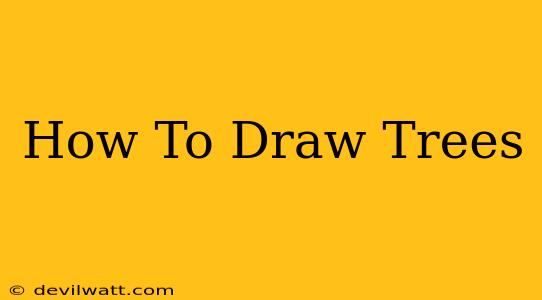Drawing trees might seem daunting, but with the right techniques and a little practice, you can master the art of depicting these natural wonders on paper. This comprehensive guide will walk you through various methods, from simple sketches to more detailed illustrations, catering to all skill levels. Whether you're a complete beginner or looking to refine your existing skills, you'll find valuable tips and tricks here.
Understanding Tree Anatomy: The Foundation of Realistic Drawings
Before you even pick up your pencil, it's crucial to understand the basic structure of a tree. This knowledge will inform your drawing and make it look more realistic. Consider these key elements:
- Trunk: The thick, central part of the tree, providing support and transporting water and nutrients. Observe its shape – it’s rarely perfectly straight! Note the texture, often rough and textured with bark.
- Branches: These extend from the trunk, creating the tree's overall shape and structure. Pay attention to how branches grow – often reaching upwards towards the light, with smaller branches branching out further.
- Leaves/Needles: These are the essential components for photosynthesis. Their shape, density, and arrangement vary greatly depending on the species of tree. Consider the overall "mass" of the foliage.
- Roots: While usually hidden beneath the ground, understanding the root system helps to ground the tree and add realism to your drawing.
Different Tree Types: Unique Characteristics to Capture
Different trees have different characteristics. Understanding these variations will significantly improve your tree drawings:
- Deciduous Trees: These lose their leaves seasonally. Consider the shape of their branches when leaves are absent, which are often more visible in winter.
- Coniferous Trees: These retain their needles year-round, often exhibiting a more conical or pyramidal shape.
- Fruit Trees: These often have more spreading branches and unique features like fruit!
Step-by-Step Guide to Drawing a Tree
Let's walk through a simple method for drawing a tree:
- Start with the Trunk: Begin by sketching a simple, irregular line for the trunk. Don't worry about perfection; slight imperfections make it look more natural.
- Add Major Branches: Extend the main branches from the trunk, keeping in mind the upward growth pattern and general shape of the tree.
- Sketch Smaller Branches: Add smaller branches that emerge from the major ones, creating a complex network.
- Outline the Foliage: Lightly sketch the overall shape of the foliage, indicating the general mass of leaves. Don't try to draw every single leaf!
- Add Detail: Once the basic structure is complete, add details like texture to the bark, varying the thickness of branches, and suggesting the individual leaves or needles.
- Refine and Shade: Use shading to create depth and realism. Darker areas indicate shadows and recesses, while lighter areas represent highlighted sections.
Advanced Techniques for Realistic Tree Drawings
Once you’ve mastered the basics, consider these techniques to elevate your tree drawings:
- Perspective: Understanding perspective will add depth and realism to your work.
- Light and Shadow: Mastering light and shadow effects can transform your drawings. Observe how light interacts with the tree’s form.
- Texture: Experiment with different techniques to render the textures of bark, leaves, and needles.
- Value Studies: Practice creating value studies to improve your understanding of light and shadow.
Essential Tools and Materials
You don't need expensive materials to draw trees. Here's what you'll need:
- Pencils: A range of graphite pencils (e.g., H, HB, 2B, 4B) offers versatility for creating different tones.
- Eraser: A kneaded eraser is great for lifting and blending.
- Paper: Use drawing paper that is suitable for pencil work.
- Sharpener: Keep your pencils sharp for precise lines.
Practice Makes Perfect!
Drawing trees is a skill that improves with practice. The more you draw, the better you'll become at capturing their unique forms and details. Don't be afraid to experiment, and most importantly, have fun! Observe trees in your surroundings, study photos, and continuously refine your techniques. Soon you’ll be creating stunningly realistic tree drawings!

